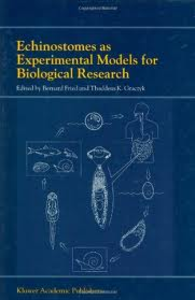Molecular biology of echinostomes
Morgan, Jessica A., and Blair, David (2000) Molecular biology of echinostomes. In: Fried, Bernard, and Graczyk, Thaddeus K., (eds.) Echinostomes as Experimental Models for Biological Research. Kluwer Academic Publishers, Dordrecht, The Netherlands, pp. 245-266.
|
PDF (Published Version)
- Published Version
Restricted to Repository staff only |
||
![[img]](https://researchonline.jcu.edu.au/14278/2.hassmallThumbnailVersion/14278_Blair_%26_Morgan_2000_front_cover.jpg)
|
Image (JPEG) (Front Cover)
- Cover Image
Download (7kB) |
Abstract
[Extract] Although most molecular srudies on echinostomes have focused on species identification and systematics, molecular techniques are not limited to these fields. Over the past decade molecular technology has advanced at a rapid Tale; techniques are now available to investigate gene expression (Schechtman t!t 01., 1995 working on an mRNA protein in Schistosoma), to resolve protein Structure and function (Davis, 1997 studying spliced leader RNAs in flatworms), 10 detemine genome organisation (Boore 1999 reviewed the mitochondrial genome) and for species diagnostics and vaccine development (Bergquist 1995 looking al possible vaccines for schistosomiasis).
Early molecular studies involved counting chromosomes and comparing isoenzyme panems (Churchill, 1950, Voltz el at., 1981). These techniques were limited by low resolution due to a lack of variation (Mutafova, 1994). Modem molecular tools, such as DNA sequencing, the characterisation of micro satellites and the expression of genes, are able to target regions of high or low variation.
Although publications on echinostome biology appeared well over a century ago (Frolich, 1802). the majority of molecular studies nave been published in the past decade. Some of the earliest studies involved karyotyping or chromosome counting and comparisons. The karyotype of Echinostoma trivolvis (referred to as E. revulunim) was described in 1950 by Churchill (Churchill, 1950). Other early studies used methods such as isoelectric focusing and enzyme electrophoresis to compare adults (Vasilev et al., 1978; Voltz, Richard and Pessod 1981; Ross et at., 1989). With the advent of PCR technology in the late 1980s questions requiring higher resolution could be answered. In 1995 DNA sequencing and RAPD analysis (Randomly Amplified Polymorphic DNA) were used to compare a number of echinostome species (Morgan and Blair, 1995; Fujino et al 1995). DNA sequences are currently being used to confirm the identity of echinostome species and strains, and to match adult and larval stages.
| Item ID: | 14278 |
|---|---|
| Item Type: | Book Chapter (Research - B1) |
| ISBN: | 978-0-7923-6156-5 |
| Related URLs: | |
| Date Deposited: | 14 Dec 2010 04:21 |
| FoR Codes: | 06 BIOLOGICAL SCIENCES > 0603 Evolutionary Biology > 060399 Evolutionary Biology not elsewhere classified @ 100% |
| SEO Codes: | 97 EXPANDING KNOWLEDGE > 970106 Expanding Knowledge in the Biological Sciences @ 100% |
| Downloads: |
Total: 238 Last 12 Months: 7 |
| More Statistics |



